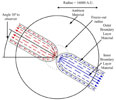- Eric Keto's Home Page
- High Mass Stars
- Starless Cores
- Extragalactic
- Radiative Transfer
- Hydrodynamics
- SMA Instrumentation
- IR Instrumentation
- MOLLIE radiative transfer
- Keto Prize
- Textbooks
| The Spectral Signatures of Molecules in Space | ||||
|
Abstract CO isotopes are able to probe the different components in protostellar clouds. These components, core, envelope and outflow have distinct physical conditions, and sometimes more than one component contributes to the observed line profile. In this study, we determine how CO isotope abundances are altered by the physical conditions in the different components. We use a 3D molecular line transport code to simulate the emission of four CO isotopomers, 12CO J = 2 -> 1, 13CO J = 2 -> 1, C18O J = 2 -> 1 and C17O J = 2 -> 1 from the Class 0/1 object L483, which contains a cold quiescent core, an infalling envelope and a clear outflow. Our models replicate James Clerk Maxwell Telescope (JCMT) line observations with the inclusion of freeze-out, a density profile and infall. Our model profiles of 12CO and 13CO have a large linewidth due to a high-velocity jet. These profiles replicate the process of more abundant material being susceptible to a jet. C18O and C17O do not display such a large linewidth as they trace denser quiescent material deep in the cloud. Patrick B. Carolan, Matthew P. Redman, Eric Keto & Jonathan M.C. Rawlings, 2008, MNRAS, 383, 705
Abstract We develop a method of analyzing radio-frequency spectral line observations to derive data on the temperature, density, velocity, and molecular abundance of the emitting gas. The method incorporates a radiative transfer code with a new technique for handling overlapping hyperfine emission lines within the accelerated -iteration algorithm and a heuristic search algorithm based on simulated annealing. We apply this method to new observations of N2H+ in three Lynds clouds thought to be starless cores in the first stages of star formation and determine their density structure. A comparison of the gas densities derived from the molecular line emission and the millimeter dust emission suggests that the required dust mass opacity is about 1.3mm=0.04 cm^2/g, consistent with models of dust grains that have opacities enhanced by ice mantles and fluffy aggregrates. Eric R. Keto, George B. Rybicki, Edwin A. Bergin & Rene Plume, 2004, ApJ, 613, 355
Abstract This paper describes a procedure for simulating spectral line images of three-dimensional molecular clouds. It is suggested that this technique can be useful in the more general problem of determining the three-dimensional structure of molecular clouds. The technique is demonstrated by comparing observed and simulated images of the accretion flow associated with high-mass star formation in the region G10.6 - 0.4. As a result of the comparison, the temperature, density, and velocity fields are described, and a vector map of the accretion flow direction and magnitude is presented. The results indicate that the molecular cloud core is strongly condensed and has approximately equal velocities in rotation and infall at its current evolutionary state. The rapid collapse and lack of rotational support suggests that significant angular momentum transfer is occurring over scales at least as large as those observed (0.5 pc). A milligauss magnetic field would have sufficient energy to supply the required braking torque of 10 to the 47th ergs. Eric R. Keto 1990, ApJ, 355, 1990
| ||||
|
|



